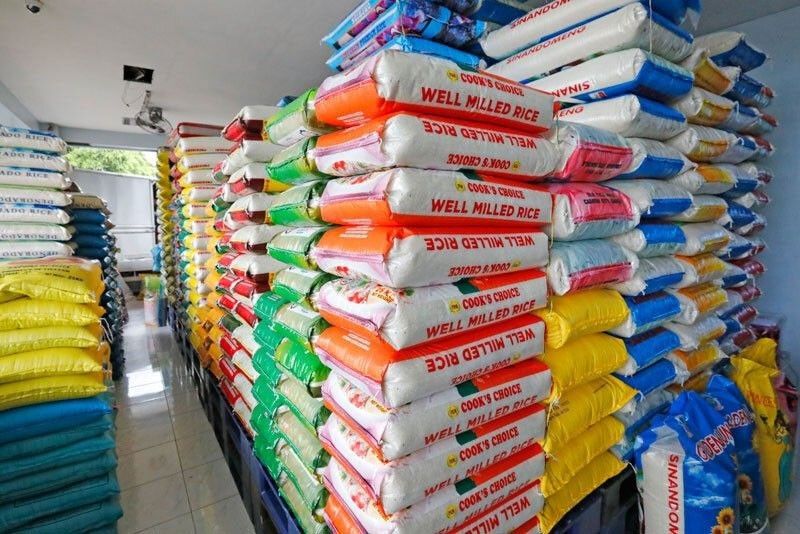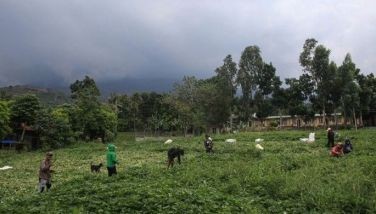Prices of rice seen going up

MANILA, Philippines — Retail prices of rice are expected to go up in the next few weeks due to low buffer stock, high farmgate prices of palay amid the dry season and the rising cost of imported rice, an official of the Department of Agriculture (DA) said yesterday.
DA Assistant Secretary and deputy spokesman Rex Estoperez said the agency is projecting an increase of up to P5 per kilo of rice.
“During the dry harvest season, prices normally shoot up because the rice is already dry. Plus, the fact that our inputs are also increasing,” Estoperez said.
He cited the high price of rice procurement at P22 to P23 per kilo.
“If the procurement price continues to rise, the market price will also rise. When we say that the farmgate price will increase, the market price will also increase,” Estoperez said.
Earlier, the Philippine Statistics Authority reported that the price of the staple increased by 2.6 percent in March this year compared to 2.2 percent recorded during the same period last year.
Also influencing the retail price of the staple is the country’s rice inventory, which only covers 51 days compared to the normally maintained 90-day buffer to cover private and government inventories.
“We need to sustain that. That’s why we say buffer stock to tide us over whatever calamity will come. Like for example, PAGASA’s (state weather bureau) advisory said El Niño is coming. Therefore, there is a need for a buffer stock, because we don’t know how big the impact will be,” Estoperez said.
“If we have (enough) buffer stock, prices can stabilize. Based on our Rice Tariffication Law (RTL), we can continuously import. The problem is, when there is speculation that the Philippines will import, our source countries are also experiencing higher prices,” he said.
Estoperez said the rising retail prices of rice are also felt outside the country.
“The price increase is happening globally at the moment. This is not only happening to us, especially that inputs are also affected by the Ukraine-Russia war,” he said.
Based on DA’s monitoring in Metro Manila markets as of April 4, retail prices of local commercial rice range between P48 to P60 per kilo for special, P42 to P49 for premium, P39 to P46 for well-milled and P34 to P40 per kilo for regular milled.
On the other hand, prices of imported commercial rice range between P50 to P58 per kilo for special, P43 to P52 for premium, P40 to P46 for well-milled and P37 to P44 per kilo for regular milled.
But once rice imports under the RTL enter the country, prices will stabilize, Estoperez said.
“The P5 per kilo increase is only a projection. What we are saying is it may not be possible when our imports come in through the RTL. It may not reach P5 per kilo if our importers bring in their rice quickly. Except there is a condition, it must not come during harvest season.”
He said that rice was among the main contributors in the 7.6 inflation rate recorded last month.
“Even with the continuous rice importation, prices from the port of origin are already high plus the fact that during the summer harvest, the procurement price is also high at P22 to P22.5 a kilo,” Estoperez said.
He said there is a proposal to increase the inventory of the National Food Authority from 51 to 90 days and the summer harvest is enough to tide over the lean months.
The country’s daily rice consumption is high, estimated at 37.6 tons, which he said pulls down the inventory despite an increase in production.
Under the RTL, tariff collections from rice imports in excess of P10 billion in a given year will be earmarked for cash transfers to farmers adversely affected by importation.
Estoperez welcomed a report of the PSA that showed food inflation dropped to 9.5 percent in March from 11.1 percent in February.
“We were able to address the prices of vegetables and sugar and all other food items except rice. We are happy to say that we worked it out to bring down the retail prices and we are confident that we will be able to do it to the price of rice in the next few months. Even though we have El Niño, we will determine what interventions we have to do to at least temper the prices of rice,” he said.
In 2022, the country imported at least 3.8 million metric tons (MT) of rice.
Latest data from the Bureau of Plant Industry showed that as of March 30, total rice imports from January to March reached 744,253 MT.
The country sourced the bulk of rice imports from Vietnam with 653,875 MT, followed by Myanmar with 53,035 MT, Thailand 33,880, India 1,784, Pakistan 1,697, China 1,560 and Japan with 422 MT.
SRP on sugar
Estoperez said the government targets to implement the P85 to P90 per kilo suggested retail price (SRP) on refined sugar this month, alongside the P70 per kilo of seized sugar at Kadiwa outlets.
He said the DA and Sugar Regulatory Administration (SRA) would meet with stakeholders to finalize the imposition of an SRP on refined sugar amid the high retail prices in the market.
“We will consult with the stakeholders as they are the ones most affected. According to SRA board member and farmers’ representative Pablo Azcona, we need to meet with the millers and planters. What is important is that if it’s imported, it should not be below the landed cost and for the local, it should not be less than the cost of production,” Estoperez said.
Latest DA monitoring in Metro Manila markets showed that retail prices of refined sugar ranged between P85 ro P110 per kilo, washed sugar between P80 ro P95 and brown sugar between P78 ro P95 per kilo.
“We are trying to expedite this (SRP) but since it’s Holy Week, it could be implemented after the holiday together with the P70 per kilo of seized sugar in Kadiwa centers,” Estoperez added.
He said the DA has ordered the SRA to fast-track the release of imported sugar in local markets to help bring down retail prices.
Azcona defended the P85 to P90 per kilo SRP on sugar, saying the government needs to consider local producers.
“The problem is we have at least 1.8 million metric tons of local production and if you consider all the added cost, it is a little over P80 per kilo. The 440,000 MT of imported sugar is somewhere around P60 per kilo. The average cost in the market is P73 per kilo as it passes through several hands. Local producers will also earn from the P85 per kilo SRP,” Azcona said.
He said at least 115,000 MT of imported sugar have arrived in the country and 40,000 MT of this have been released in the market.
- Latest
- Trending































